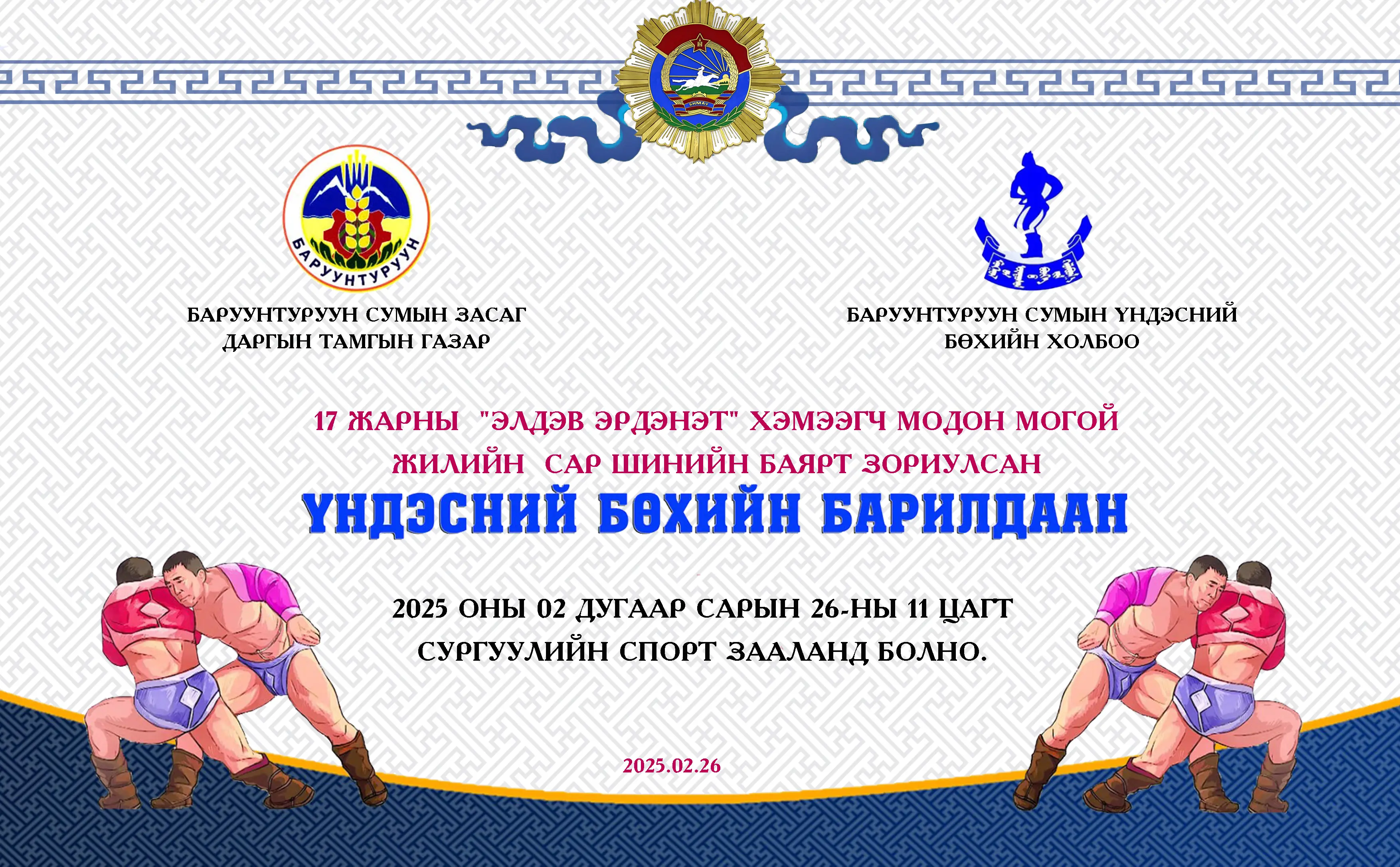.webp)
Location and general geographical features of the soum
News
See all
About Us
The territory of Baruunturuun soum borders the Russian Federation in the east of the aimag to the north, Zavkhan aimag and Zuunkhangai soum to the east, Undurkhangai and Tsagaankhairkhan soums to the southeast and south, and Zuungovi and Khyargas soums to the west and northwest. The total area of the soum is 329.2 thousand hectares, which is 4.7 percent of the total area of the aimag. 278.3 thousand hectares or 54.1 percent of the total area of the soum is occupied by agricultural land, 7.6 thousand hectares by forest, 2520 hectares by water fund, and 625 hectares by urban areas.
The most distant point from the soum center is 105 km to Nisekh Mountain, 1150 km from Baruunturuun to Ulaanbaatar, 188 km to the aimag center, and 140 km to the Khar Termes resort on Khyargas Lake. In the dry basins of the West, Zuunturuun, and Khangiltsag rivers, there are 42.3 thousand hectares of land for growing rice and various types of fodder crops, and 2.0 thousand tons of good quality natural hay such as sogoovor, bed, and yerkhug. In addition to 1643 hectares of hay fields, sandy loam, and 229.6 thousand hectares of livestock pastures mainly with borog, shavag, wormwood, and kee grass in the Khangai mountains, the Golden Sand Loam is a dry Gobi desert like the Sahara River. In the mountains, black trees, gachur, willow, and poplar grow, as well as fruits and medicinal plants.
There are forests and natural beauties of Tost, Uyanga, Khyarsny Bulag, and neighboring areas of Undurkhangai soum such as Altan burgas, Bushtag, and Khorin bugat. The Zuun Baruun Narin River, which originates directly from the sand in the northwestern part of the Altan Els soum, flows and empties into Uvs Lake. At the beginning of this river, willow and birch trees grow from the sand. Also, less than 20 km beyond the Narin River, on the northern edge of the sand, there is Lake Doroo. Lake Doroo has clear, clean water, edible fish such as carp, and springs that originate from the sand into Lake Doroo. The front part of the lake. It has a unique area covered with forests such as blackwood, willow, and poplar. In the eastern part of Altan Els, where the sand is decreasing, there is a unique area where blackwood grows in the sand. It is called the Blackwood Hole, and it can be reached by car from the eastern side of the Altan Els nature reserve. About 30 km east of Kharmodon Suv, the Tesin River, which originates in the Bulnai Range of Mongolia, flows for more than 10 km through the soum and enters the territory of the Erzin District of the Tuva Republic of the Russian Federation. In this area, there are places with unique formations of dense thickets, making it difficult for people and livestock to travel. On the Mongolian side of the Russian-Mongolian border, there is a steep, high, bare red mountain called “Nisekh” reminiscent of the Altai Mountains. This is an example of a mountain that is devoid of forests and reflects the unique formations of the Gobi. Thus, the territory of the soum is a soum with an abundance of lakes, rivers, and springs that preserve the characteristics of both the Gobi, steppe, Khangai, and the high alpine regions of the Altai. The Tost, Khyarsyn Bulag, Uyanga, and the source of the Khar Tsagaan Usin rivers have unique formations of rock caves, and deciduous and coniferous forests such as larch, birch, and willow.
In the above-mentioned mountainous areas, there are deer, roe deer, foxes, wild boars, badgers, and woodpeckers, lynxes, and squirrels. There are also skunks, white-tailed deer, dog lynxes, marmots, skunks, brown hares, zurams, and marmots. In the forests and mountains, there are fruits such as gooseberries, redcurrants, strawberries, toshloy, and nuts, as well as edible plants such as onions, leeks, potatoes, and various mushrooms.
In the territory of the soum, there are steppe geese, angir, wild ducks, yavlag sar, tsar, blind elee, steppe white, liver brown, eagle, peregrine falcon, khur, khutu, common soyr, harhiraa crane, toodog, khavtaalj /hundred lamb/ gull, nogtruu, kukvur, dove, cuckoo, old world flycatcher, owl, owl, erguu brown, woodpecker, lark, steppe swallow, horse tsogchookhoi, magpie, alagtuu, turliah, hon raven, red hawk, and other birds.
Medicinal and edible herbs are abundant. Asian grass, aji, medicinal baguakhai, gurmasan ajig, narrow-leaved kavan, meadow semtegulee, ikh tan salaa, bag tarana, cow meeer, goose beetroot, medicinal soda, black bilberry, steppe sedergene, wave bishuun, hurgan chih, dam puruu, creeping khiag, hurgan meeer, blue fig, Siberian heart flower, creeping ganja, golden gundaga, horse anemone, medicinal golden gobi, ajig tseren, and sod are abundant in the mountains and steppes.
Rivers and lakes There are streams and springs such as the Turun River, which originates behind the Khankhokhi Range, the Khangiltsa River, which originates from the West Khangiltsa Pass, Zuunturuun, Ikh baga Khujirt, Khyarsyn Bulag, Urd hoit Khokh Gol, Bayan-Airag Khavchig, Khuv, and Khar tsagaan Us. It originates from the East-West Naryn River. It has Lake Doro, an artificial lake with a capacity of 8 million m3 for the irrigation system. The eastern part of the famous Tes River flows for more than 10 km through the Nisekh Bay and enters Tuva. It has springs such as Yargait, Khujirt, Biluu, and Mogoin Rivers.
Contact Us
89508211
SUB ORGANIZATIONS
RELATED ORGANIZATIONS
Subscribe
If you want to receive new updates regularly without delay, please enter your email here to subscribe.
